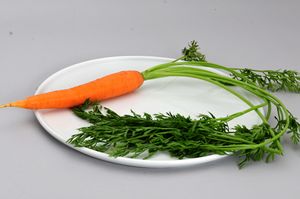Note: This is a project under development. The articles on this wiki are just being initiated and broadly incomplete. You can Help creating new pages.
Daucus carota - Garjarah
The carrot (Daucus carota subsp. sativus) is a root vegetable, usually orange in colour, though purple, black, red, white, and yellow varieties exist. Carrots are a domesticated form of the wild carrot Daucus carota, native to Europe and southwestern Asia. The plant probably originated in Persia and was originally cultivated for its leaves and seeds. Nowadays, the most commonly eaten part of the plant is the taproot, although the greens are sometimes eaten as well. The domestic carrot has been selectively bred for its greatly enlarged and more palatable, less woody-textured taproot.
The carrot is a biennial plant in the umbellifer family Apiaceae. It grows a rosette of leaves in the spring and summer while building up the stout taproot. Fast-growing varieties mature within three months of sowing the seed, while slower-maturing varieties are harvested in autumn and winter. The roots contain high quantities of alpha and beta carotene, and are a good source of vitamin K and vitamin B6. The belief that eating carrots improves night vision is a myth, put forward by the British in World War II to mislead the enemy.
The Food and Agriculture Organization of the United Nations (FAO) reports that world production of carrots and turnips (these plants are combined by the FAO for reporting purposes) for calendar year 2013 was 37.2 million tonnes. Almost half were grown in China. Carrots are widely used in many cuisines, especially in preparation of salads, and carrot salads are a tradition in many regional cuisines.
